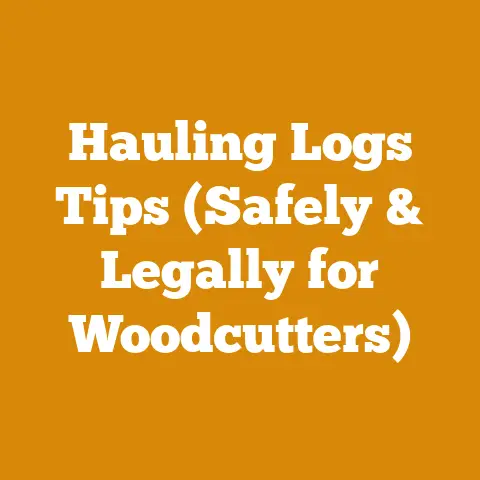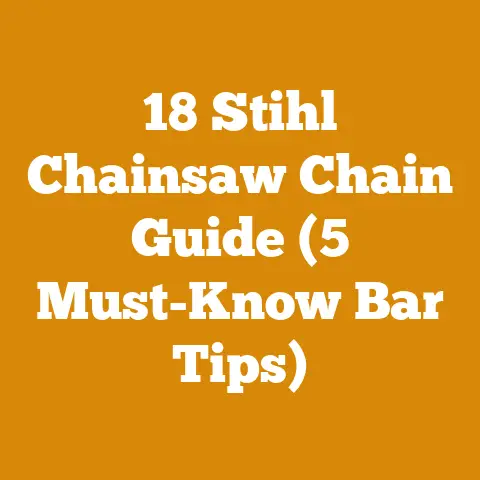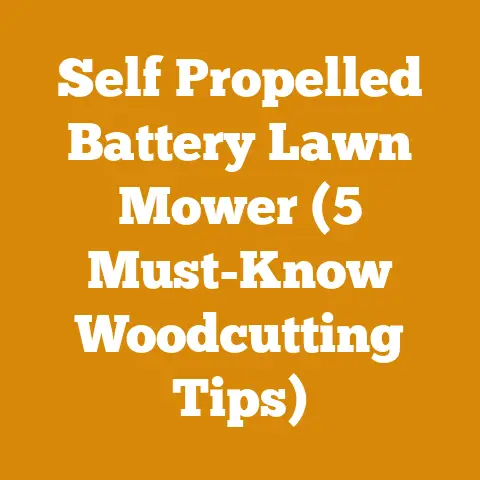Leyland Cypress Life Span Explained (Timber Durability Insights)
The crisp autumn air bites at my cheeks as I survey the stack of freshly felled Leyland Cypress logs. The scent of resin hangs heavy, a bittersweet fragrance that always reminds me of long days spent in the woods. This year, I’m not just harvesting for firewood; I’m exploring the potential of Leyland Cypress as a timber source. A question keeps nagging at me: how long will this wood last? And, more importantly, is it worth the investment of time and effort to process?
The Leyland Cypress, with its rapid growth and dense foliage, is a popular choice for privacy screens and windbreaks. But its reputation as a timber species is less clear-cut. Some swear by its versatility, while others dismiss it as little more than glorified firewood. The truth, as I’ve discovered, lies somewhere in between.
Understanding Leyland Cypress: A Primer
Before we dive into the specifics of durability, let’s establish a solid foundation. Leyland Cypress ( × Cuprocyparis leylandii) is a hybrid evergreen tree, a cross between Monterey Cypress and Alaskan Cedar. This hybrid vigor contributes to its rapid growth rate, often reaching heights of 60-70 feet in a relatively short time.
However, its fast growth also influences its wood characteristics. Leyland Cypress typically has a straight grain, a relatively soft texture, and a pale yellow-brown color. Its density is moderate, ranging from 28 to 32 pounds per cubic foot when dry, placing it somewhere between Eastern White Pine and Southern Yellow Pine in terms of hardness.
The Good, the Bad, and the Ugly: Leyland Cypress Pros and Cons
Like any timber species, Leyland Cypress has its strengths and weaknesses. Understanding these is crucial for making informed decisions about its use.
Pros:
- Rapid Growth: This translates to a quicker return on investment for those growing it for timber.
- Ease of Milling: Its relatively soft texture makes it easy to work with hand tools and machinery.
- Dimensional Stability: Leyland Cypress is less prone to warping and twisting than some other softwoods.
- Availability and Cost: In many regions, it’s readily available and often more affordable than premium hardwoods.
- Accepts Finishes Well: It takes paint and stain readily, allowing for a variety of aesthetic options.
Cons:
- Durability: This is the primary concern. Leyland Cypress is not naturally rot-resistant and is susceptible to insect damage.
- Knotty Wood: Depending on the growing conditions, Leyland Cypress can have numerous knots, which can affect its structural integrity and appearance.
- Weakness: It’s not as strong as hardwoods like oak or maple, limiting its use in high-stress applications.
- Requires Treatment: To extend its lifespan, Leyland Cypress typically needs to be treated with preservatives.
Leyland Cypress Lifespan: Factors at Play
The lifespan of Leyland Cypress timber is not a fixed number. It’s influenced by a complex interplay of factors, including:
- Environmental Conditions: Exposure to moisture, sunlight, and fluctuating temperatures significantly impacts its longevity.
- Treatment and Preservation: Proper treatment with preservatives can dramatically extend its lifespan.
- Application: The intended use of the timber plays a crucial role. Interior applications will last much longer than exterior ones.
- Harvesting and Drying Practices: Proper harvesting and drying techniques minimize the risk of decay and warping.
- Geographic Location: Climate and soil conditions in different regions can affect the wood’s natural resistance to decay.
Untreated Leyland Cypress: A Race Against Time
In my experience, untreated Leyland Cypress used outdoors has a relatively short lifespan. Without protection, it’s vulnerable to fungal decay and insect infestation.
- Above Ground: Expect untreated Leyland Cypress to last anywhere from 3 to 7 years above ground, depending on the climate. In humid environments with frequent rainfall, the lifespan will be at the lower end of this range.
- In Ground Contact: When in direct contact with the soil, untreated Leyland Cypress is likely to rot within 1 to 3 years. The constant moisture and presence of wood-decaying organisms accelerate the decomposition process.
These figures are based on my observations and anecdotal evidence from other woodworkers. However, it’s important to note that these are estimates. The actual lifespan can vary depending on the specific conditions.
Treated Leyland Cypress: Extending the Timber’s Tenure
The good news is that the lifespan of Leyland Cypress can be significantly extended through proper treatment with wood preservatives.
- Pressure-Treated: Pressure-treating involves forcing preservatives deep into the wood’s cells under high pressure. This method provides the most effective protection against rot and insects. Pressure-treated Leyland Cypress can last 20 to 40 years or even longer in above-ground applications, and 10 to 20 years in ground contact.
- Brush-On or Spray-On Preservatives: These surface treatments offer less protection than pressure-treating but can still extend the lifespan of Leyland Cypress. Expect a lifespan of 5 to 10 years above ground with regular reapplication of the preservative.
The choice of preservative depends on the intended use of the timber. For projects involving ground contact, opt for preservatives specifically designed for that purpose. Always follow the manufacturer’s instructions carefully when applying preservatives.
Interior Applications: A Long and Useful Life
When used indoors, Leyland Cypress can last for decades, even without treatment. Protected from the elements, it’s less susceptible to decay and insect damage.
- Furniture: Leyland Cypress can be used to build furniture, although it’s best suited for pieces that don’t require high strength. Expect a lifespan of 20 years or more with proper care.
- Paneling and Trim: Leyland Cypress is an attractive option for interior paneling and trim. With proper finishing, it can last for 50 years or more.
- Craft Projects: Its ease of workability makes it a popular choice for craft projects. These projects can last indefinitely with proper care.
Applications: Where Leyland Cypress Shines (and Where it Doesn’t)
Knowing the strengths and weaknesses of Leyland Cypress is crucial for selecting appropriate applications. Here’s a breakdown of where it excels and where it falls short:
Suitable Applications:
- Exterior Trim (Treated): When properly treated, Leyland Cypress can be used for exterior trim, such as fascia boards, soffits, and window casings.
- Siding (Treated): With pressure treatment and proper installation, Leyland Cypress can be used for siding, offering a cost-effective alternative to more expensive options.
- Fencing (Treated): While not as durable as cedar or redwood, pressure-treated Leyland Cypress can be a viable option for fencing, especially in areas with less harsh climates.
- Furniture (Interior): Leyland Cypress can be used to build furniture for interior use, such as tables, chairs, and cabinets.
- Paneling and Trim (Interior): Its attractive grain and ease of workability make it a good choice for interior paneling and trim.
- Craft Projects: Leyland Cypress is a versatile material for a wide range of craft projects.
- Firewood: Of course, Leyland Cypress makes decent firewood, though it burns quickly.
Unsuitable Applications:
- Structural Framing: Leyland Cypress is not strong enough for structural framing in buildings or other load-bearing applications.
- Decks: Due to its lack of natural rot resistance, Leyland Cypress is not recommended for decks, even when treated.
- Outdoor Furniture (Untreated): Untreated Leyland Cypress will quickly deteriorate when exposed to the elements.
- Boat Building: Leyland Cypress is not suitable for boat building due to its lack of water resistance.
The Cost of Leyland Cypress: A Budget Breakdown
Now, let’s get down to brass tacks: the cost. Understanding the expenses involved in harvesting, processing, and utilizing Leyland Cypress is essential for making informed decisions. I’ll break down the costs into several categories:
Timber Acquisition Costs
The cost of acquiring Leyland Cypress timber can vary widely depending on several factors:
- Standing Timber vs. Purchased Lumber: If you own the land and harvest the trees yourself, your costs will be lower than purchasing lumber from a supplier.
- Location: Timber prices vary depending on geographic location and local market conditions.
- Quality: The quality of the timber, including its size, straightness, and freedom from defects, will affect its price.
- Volume: Purchasing larger volumes of timber often results in lower prices per unit.
Estimating Timber Acquisition Costs:
- Standing Timber: If you’re harvesting your own trees, you’ll need to factor in the cost of felling, skidding, and transporting the logs. These costs can range from $50 to $150 per thousand board feet (MBF), depending on the size of the trees and the terrain.
- Purchased Lumber: Leyland Cypress lumber typically sells for $2 to $4 per board foot, depending on the grade and dimensions. This is generally less expensive than premium hardwoods like oak or cherry.
My Experience:
I’ve found that harvesting my own Leyland Cypress can be significantly cheaper than buying lumber, especially if I already have the necessary equipment. However, it’s important to factor in the time and effort involved. A weekend spent felling and skidding logs might save me money, but it also takes away from other projects.
Processing Costs
Once you’ve acquired the timber, you’ll need to process it into usable lumber. This involves milling, drying, and surfacing the wood.
- Milling:
- Portable Sawmill: Renting a portable sawmill can cost $200 to $400 per day, depending on the size and features of the mill. Hiring a professional sawyer can cost $50 to $100 per hour.
- Commercial Sawmill: Taking your logs to a commercial sawmill will typically cost $75 to $150 per MBF.
- Drying:
- Air Drying: Air drying is the most cost-effective method, but it can take several months to a year for the wood to reach the desired moisture content. The cost is minimal, primarily involving the space and labor to stack the wood properly.
- Kiln Drying: Kiln drying is a faster method, but it’s also more expensive. Commercial kiln drying can cost $100 to $300 per MBF.
- Surfacing:
- DIY: If you have a planer and jointer, you can surface the lumber yourself. The cost is primarily the wear and tear on your equipment.
- Professional Surfacing: Hiring a professional to surface your lumber can cost $0.50 to $1.00 per board foot.
My Experience:
I’ve used both portable sawmills and commercial sawmills to process Leyland Cypress. For small projects, renting a portable sawmill is a good option. It allows me to control the milling process and customize the dimensions of the lumber. However, for larger projects, I prefer to use a commercial sawmill. They have the equipment and expertise to process large volumes of timber efficiently.
Treatment Costs
If you plan to use Leyland Cypress outdoors, you’ll need to factor in the cost of treatment.
- Pressure Treating: Pressure treating is typically done by commercial facilities. The cost can range from $0.50 to $1.50 per board foot, depending on the type of preservative used and the volume of lumber being treated.
- Brush-On or Spray-On Preservatives: The cost of these preservatives varies depending on the brand and type. Expect to pay $20 to $50 per gallon. A gallon of preservative will typically cover 200 to 400 square feet, depending on the application rate.
My Experience:
I’ve used both pressure-treated Leyland Cypress and brush-on preservatives. Pressure-treated lumber is more expensive upfront, but it provides superior protection against rot and insects. For smaller projects, I often use brush-on preservatives, reapplying them every few years to maintain protection.
Labor Costs
If you’re not doing the work yourself, you’ll need to factor in labor costs. These costs will vary depending on the skill level of the workers and the complexity of the project.
- General Labor: Expect to pay $15 to $25 per hour for general labor, such as stacking lumber or applying preservatives.
- Skilled Labor: Skilled labor, such as milling lumber or building furniture, can cost $30 to $50 per hour.
My Experience:
I’ve found that hiring skilled labor is often worth the investment, especially for complex projects. A skilled carpenter can complete the work faster and more efficiently, saving me time and money in the long run.
Tool and Equipment Costs
If you’re planning to process Leyland Cypress yourself, you’ll need to invest in the necessary tools and equipment.
- Chainsaw: A good quality chainsaw can cost $200 to $500.
- Portable Sawmill: Renting a portable sawmill can cost $200 to $400 per day.
- Planer and Jointer: A planer and jointer can cost $500 to $2000 each.
- Safety Gear: Safety gear, such as a helmet, eye protection, and hearing protection, can cost $50 to $100.
My Experience:
I’ve gradually accumulated the tools and equipment I need for processing Leyland Cypress. Starting with a good chainsaw and basic hand tools, I’ve added more specialized equipment as my skills and projects have grown.
Miscellaneous Costs
Don’t forget to factor in miscellaneous costs, such as:
- Transportation: The cost of transporting logs and lumber.
- Permits: Permits may be required for harvesting timber.
- Waste Disposal: The cost of disposing of waste wood and sawdust.
Case Study: Building a Leyland Cypress Fence
Let’s look at a real-world example to illustrate the costs involved in using Leyland Cypress. Suppose I want to build a 100-foot-long fence using pressure-treated Leyland Cypress.
Materials:
- 4×4 posts (10 posts): $20 each = $200
- 2×4 rails (100 feet): $1 per foot = $100
- 1×6 pickets (600 feet): $0.50 per foot = $300
- Fasteners: $50
Total Materials Cost: $650
Labor:
- Post installation (10 posts): 2 hours per post x $30/hour = $60
- Rail installation (100 feet): 4 hours x $30/hour = $120
- Picket installation (600 feet): 8 hours x $30/hour = $240
Total Labor Cost: $420
Equipment Rental:
- Post hole digger rental: $50
Miscellaneous Costs:
- Transportation: $50
Total Project Cost: $650 (materials) + $420 (labor) + $50 (equipment) + $50 (miscellaneous) = $1170
This fence would cost approximately $11.70 per foot. This is a relatively low cost compared to other fencing materials like cedar or vinyl.
Tips for Cost Optimization
Here are some practical tips for optimizing costs when working with Leyland Cypress:
- Harvest Your Own Timber: If you have access to Leyland Cypress trees, harvesting your own timber can save you money.
- Air Dry Your Lumber: Air drying is a cost-effective way to dry lumber, although it takes longer.
- Buy in Bulk: Purchasing lumber and preservatives in bulk can often result in lower prices.
- Shop Around: Compare prices from different suppliers to find the best deals.
- Do It Yourself: Performing as much of the work as possible yourself can save you money on labor costs.
- Minimize Waste: Plan your projects carefully to minimize waste and avoid unnecessary material costs.
- Use Recycled Materials: Consider using recycled materials, such as reclaimed lumber, for certain parts of your projects.
- Proper Storage: Store your lumber properly to prevent damage and decay.
Conclusion: Leyland Cypress – A Versatile, but Not Perfect, Choice
Leyland Cypress is a versatile timber species with both advantages and disadvantages. Its rapid growth, ease of workability, and affordability make it an attractive option for a variety of applications. However, its lack of natural rot resistance means that it requires treatment for outdoor use.
By understanding the factors that affect its lifespan and carefully considering the costs involved, you can make informed decisions about whether Leyland Cypress is the right choice for your next project.
Ultimately, the decision of whether to use Leyland Cypress depends on your specific needs and priorities. If you’re looking for a cost-effective and readily available timber species for interior applications or treated exterior projects, Leyland Cypress is worth considering. But if you need a naturally durable wood for demanding outdoor applications, you may want to explore other options.
Remember, knowledge is power. The more you understand about Leyland Cypress and the costs involved in working with it, the better equipped you’ll be to make smart decisions and achieve successful woodworking projects. Now, armed with this information, you can confidently tackle your next Leyland Cypress endeavor, knowing you’ve considered all the angles and are prepared for whatever challenges may come your way. Happy woodworking!






